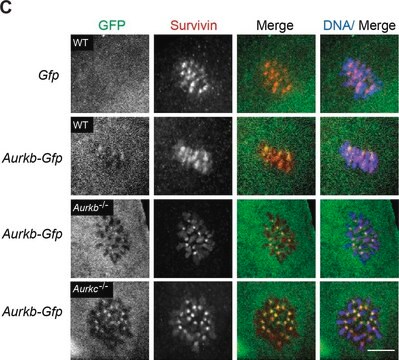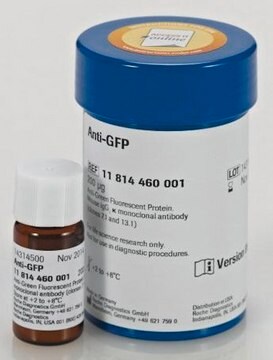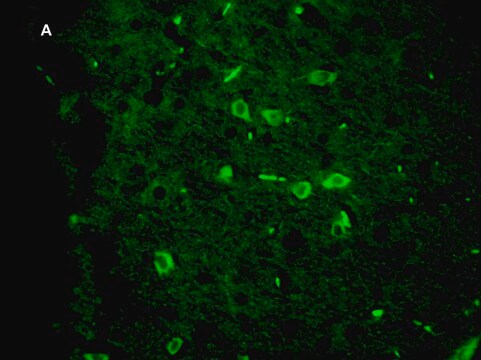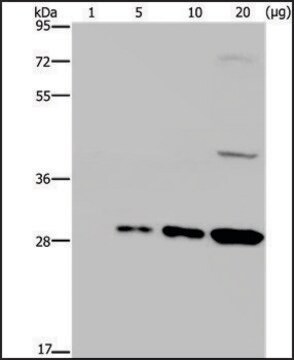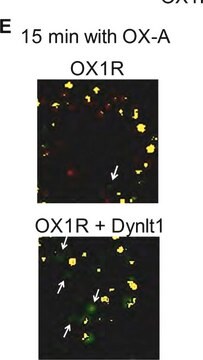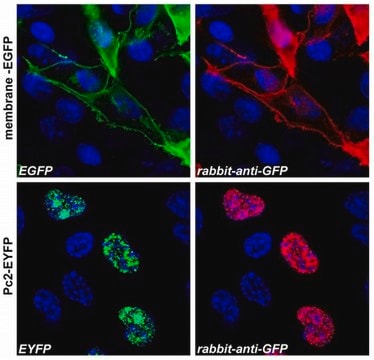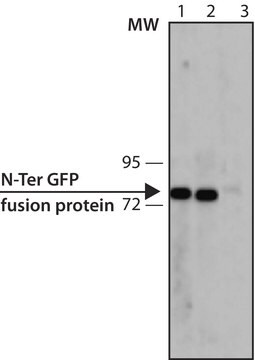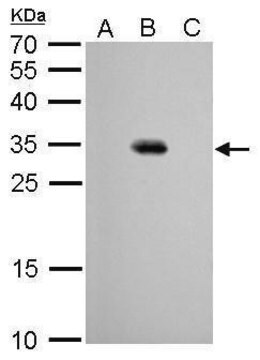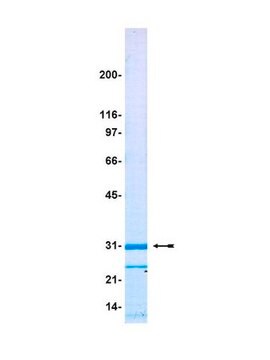G6795
Anti-Green Fluorescent Protein (GFP), N-terminal antibody, Mouse monoclonal
clone GSN24, purified from hybridoma cell culture
Sinônimo(s):
Anti-GFP
Faça loginpara ver os preços organizacionais e de contrato
About This Item
Código UNSPSC:
12352203
NACRES:
NA.56
Produtos recomendados
fonte biológica
mouse
conjugado
unconjugated
forma do anticorpo
purified immunoglobulin
tipo de produto de anticorpo
primary antibodies
clone
GSN24, monoclonal
Formulário
buffered aqueous solution
peso molecular
antigen 27 kDa
concentração
~2 mg/mL
técnica(s)
western blot: 1-2 μg/mL using GFP fusion proteins expressed in extracts of transfected cells
Isotipo
IgG1
Condições de expedição
dry ice
temperatura de armazenamento
−20°C
2-8°C
modificação pós-traducional do alvo
unmodified
Descrição geral
Anti-Green Fluorescent Protein (GFP), N-terminal antibody, Mouse monoclonal (mouse IgG1 isotype) is derived from the hybridoma GSN24 produced by the fusion of mouse myeloma cells (NS1 cells) and splenocytes from BALB/c mice.
Especificidade
The antibody reacts specifically with GFP fusion proteins.
Aplicação
Anti-Green Fluorescent Protein (GFP), N-terminal antibody, Mouse monoclonal has been used in: western blotting, enzyme linked immunosorbent assay (ELISA), immunofluorescence labeling.
Ações bioquímicas/fisiológicas
Green Fluorescent Protein (GFP) is a unique tool in cellular and molecular biology research to monitor gene expression and protein localization in living cells. In the jellyfish, A. victoria, GFP transduces the excitation energy resulting from emission of blue light of the photoprotein aequorin and reemits it as green light.
forma física
Solution in 0.01 M phosphate buffered saline, pH 7.4, containing 15 mM sodium azide.
Armazenamento e estabilidade
For continuous use, store at 2–8 °C for up to one month. For extended storage, store at –20 °C in working aliquots. Repeated freezing and thawing is not recommended. If slight turbidity occurs upon prolonged storage, clarify the solution by centrifugation before use. Solutions at working dilution should be discarded if not used within 12 hours.
Exoneração de responsabilidade
Unless otherwise stated in our catalog, our products are intended for research use only and are not to be used for any other purpose, which includes but is not limited to, unauthorized commercial uses, in vitro diagnostic uses, ex vivo or in vivo therapeutic uses or any type of consumption or application to humans or animals.
Não está encontrando o produto certo?
Experimente o nosso Ferramenta de seleção de produtos.
produto relacionado
Nº do produto
Descrição
Preços
recomendado
Código de classe de armazenamento
10 - Combustible liquids
Classe de risco de água (WGK)
WGK 3
Ponto de fulgor (°F)
Not applicable
Ponto de fulgor (°C)
Not applicable
Escolha uma das versões mais recentes:
Já possui este produto?
Encontre a documentação dos produtos que você adquiriu recentemente na biblioteca de documentos.
Os clientes também visualizaram
Marta Ukleja et al.
Nature communications, 7, 10433-10433 (2016-01-26)
CCR4-NOT is a large protein complex present both in cytoplasm and the nucleus of eukaryotic cells. Although it is involved in a variety of distinct processes related to expression of genetic information such as poly(A) tail shortening, transcription regulation, nuclear
Piet Kramer et al.
Frontiers in genetics, 7, 165-165 (2016-09-30)
The mitochondrial permeability transition pore plays a key role in programmed cell death and the induction of autophagy. Opening of the pore is regulated by the mitochondrial peptidyl prolyl-cis, trans-isomerase cyclophilin D (CYPD). Previously it was shown in the aging
Matthias Wiemer et al.
F1000Research, 3, 230-230 (2014-12-19)
The degradation of damaged proteins is an important vital function especially during aging and stress. The ubiquitin proteasome system is one of the major cellular machineries for protein degradation. Health and longevity are associated with high proteasome activity. To demonstrate
Mohammad I K Hamad et al.
Development (Cambridge, England), 141(8), 1737-1748 (2014-03-29)
The ionotropic α-amino-3-hydroxy-5-methyl-4-isoxazole propionate glutamate receptors (AMPARs) have been implicated in the establishment of dendritic architecture. The transmembrane AMPA receptor regulatory proteins (TARPs) regulate AMPAR function and trafficking into synaptic membranes. In the current study, we employ type I and
Design of inducible expression vectors for improved protein production in Ralstonia eutropha H16 derived host strains
Gruber S, et al.
Journal of Biotechnology, 235(8), 92-99 (2016)
Nossa equipe de cientistas tem experiência em todas as áreas de pesquisa, incluindo Life Sciences, ciência de materiais, síntese química, cromatografia, química analítica e muitas outras.
Entre em contato com a assistência técnica